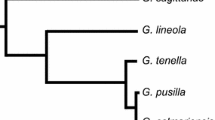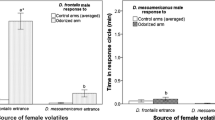Abstract
We investigated the relative importance of olfaction versus vision in the mate-finding behavior of Agrilus planipennis. When coupled in male–female, male–male and female–female pairs, attempts to mate occurred only in the male–female pairs, suggesting that beetles can identify the opposite sex before attempting to mate. In a set of sensory deprivation experiments with male–female pairs, we evaluated whether males could find females when deprived of their sense of olfaction, vision or both. Males whose antennae were blocked with model paint took significantly longer to find females and spent less time in copula compared to untreated males. Males whose eyes were similarly blocked did not differ in their mate finding capacity compared to untreated males. In a third experiment that compared both olfaction and vision, olfactorily impaired beetles never mated whereas the mate finding potential of visually impaired beetles did not differ from that of untreated beetles. Our results indicate that males can identify females before coming into physical contact with them, and that at short range (≤5 cm), volatile cues detected by olfaction are involved in mate finding by A. planipennis.




Similar content being viewed by others
References
Alcock J (1989) Animal behavior: an evolutionary approach. Sinauer, Sunderland
Allison PD (1995) Survival analysis using SAS: a practical guide. SAS Institute Inc, Cary
Bailey WJ (2003) Insect duets: underlying mechanisms and their evolution. Physiol Entomol 28:157–174
Bartelt RJ, Cossé AA, Zilkowski BW, Fraser I (2007) Antennally active macrolide from the emerald ash borer Agrilus planipennis emitted predominantly by females. J Chem Ecol 33:1299–1302
Bauer LS, Liu H, Haack RA, Gao R, Miller DL, Petrice TR (2004) Emerald ash borer life cycle. Proceedings of the Emerald Ash Borer Research and Technology Development Meeting, Morgantown,West Virginia, USDA Forest Service FHTET-2004–02
Blomquist GJ, Tillman-Wall JA, Guo L, Quilici DR, Gu P, Schal C (1996) Hydrocarbon and hydrocarbon derived sex pheromones in insects: biochemistry and endocrine regulation. In: Stanley-Samuel DW, Nelson DR (eds) Insect lipids: Chemistry, Biochemistry, and Biology. University of Nebraska Press, Lincoln Pp 317–351
Candolin U (2003) The use of multiple cues in mate choice. Biol Rev 78:575–595
Cardé RT, Minks AK (1997) Insect pheromone research: new directions. Chapman and Hall, New York
Cocroft RB, Rodriguez RL (2005) The behavioral ecology of insect vibrational communication. Bioscience 55:323–334
Dunn JP, Potter DA (1988) Evidence for sexual attraction by the two-lined chestnut borer, Agrilus bilineatus (Weber) (Coleoptera: Buprestidae). The Can Entomol 120:1037–1039
Ginzel MD, Hanks LM (2003) Contact pheromones as mate recognition cues of four longhorned beetle species (Coleoptera: Cerambycidae). J Insect Behav 16:181–187
Ginzel MD, Blomquist GJ, Millar JG, Hanks LM (2003) The role of contact pheromones in mate location and recognition in Xylotrechus colonus. J Chem Ecol 29:533–545
Gorb SN (1998) Visual cues in mate recognition by males of the damselfly, Coenagrion puella (L.) (Odonata: Coenagrionidae). J Insect Behav 11:73–92
Haack RA, Jendek E, Liu H, Marchant KR, Petrice TR, Poland TM, Ye H (2002) The emerald ash borer: A new exotic pest in North America. Newsletter of the Michigan Entomological Society 47:1–5
Howard RW, Blomquist GJ (2005) Ecological, behavioral and biochemical aspects of insect hydrocarbons. Annu Rev Entomol 50:371–393
Johansson BG, Jones TM (2007) The role of chemical communication in mate choice. Biol Rev 82:265–289
Lelito JP, Fraser I, Mastro VC, Tumlinson JH, Boroczky K, Baker TC (2007) Visually mediated “paratrooper copulations” in the mating behavior of Agrilus planipennis (Coleoptera: Buprestidae), a highly destructive invasive pest of North American ash trees. J Insect Behav 20:537–552
Lopes O, Marques PC, Araujo J (2005) The role of antennae in mate recognition in Phoracantha semipunctata (Coleoptera: Cerambycidae). J Insect Behav 18:243–257
Lu W, Wang Q, Tian MY, He XZ, Zeng XL, Zhong YX (2007) Mate location and recognition in Glenea cantor (Fabr.) (Coleoptera: Cerambycidae: Lamiinae): roles of host plant health, female sex pheromone, and vision. Environ Entomol 36:864–870
Lyons DB, Jones GC (2005) The biology and phenology of the emerald ash borer. Proceedings of the 16th USDA Interagency Research Forum on Gypsy Moth and Other Invasive Species, Annapolis, MD
McCullough DG, Roberts DL (2002) Emerald ash borer. Pest Alert New Town Square, PA, US Dep Agric Dep Agr For Serv NA-PR-07–02
Poland TM, McCullough DG (2006) Emerald ash borer: invasion of the urban forest and the threat to North America's ash resource. J Forestry 104:118–124
Raffa KF, Phillips TW, Salom SM (1993) Strategies and mechanisms of host colonization by bark beetles. In: Schowalter TD, Filip GM (eds) Beetle-pathogen interactions in conifer forests. Academic, New York, pp pp 103–128
Reagel PF, Ginzel MD, Hanks LM (2002) Aggregation and mate location in the red milkweed beetle (Coleoptera: Cerambycidae). J Insect Behav 15:811–830
Rodriguez-Saona C, Poland TM, Miller JR, Stelinski LL, Grant GG, deGroot P, Buchan L, MacDonald L (2006) Behavioral and electrophysiological responses of the emerald ash borer; Agrilus planipennis, to induced volatiles of Manchurian ash, Fraxinus mandshurica. Chemoecology 16:75–86
Rodriguez-Saona CR, Miller JR, Poland TM, Kuhn TM, Otis GW, Turk T, McKenzie N (2008) Behaviours of adult Agrilus planipennis (Coleoptera: Buprestidae). The Great Lakes Entomologist 40:1–16
SAS (2002–2003) SAS Institute Inc. Version 9.1 SAS/STAT® Users Guide Release Cary, North Carolina
Szentesi A, Weber DC, Jermy T (2002) Role of visual stimuli in host and mate location of the Colorado potato beetle. Entomol Experi Appl 105:141–152
Thornhill R, Alcock J (1983) The evolution of insect mating systems. Harvard University Press, Cambridge
Wei X, Reardon D, Wu Y, Sun J-H (2004) Emerald ash borer, Agrilus planipennis Fairmaire (Coleoptera: Buprestidae), in China: a review and distribution survey. Acta Entomol Sin 47:679–685
Wood DL (1982) The role of pheromones, kairomones and allomones in the host selection and colonization of bark beetles. Annu Rev Entomol 27:411–446
Acknowledgements
We thank G. Grant for initial discussions, T. Kuhn for laboratory assistance, J. Stanovick for statistical advice and C. Rodriguez-Saona, B. Gill, H. Liu and two anonymous reviewers for comments on earlier drafts. Financial support was provided by the USDA Forest Service Special Technology Development Program to TMP and an NSERC Visiting Fellowship to DSP from the Canadian Food Inspection Agency.
Author information
Authors and Affiliations
Corresponding author
Rights and permissions
About this article
Cite this article
Pureswaran, D.S., Poland, T.M. The Role of Olfactory Cues in Short-Range Mate Finding by the Emerald Ash Borer, Agrilus planipennis Fairmaire (Coleoptera: Buprestidae). J Insect Behav 22, 205–216 (2009). https://doi.org/10.1007/s10905-008-9166-8
Revised:
Accepted:
Published:
Issue Date:
DOI: https://doi.org/10.1007/s10905-008-9166-8




